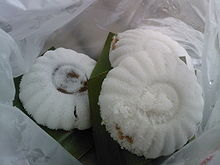Putu piring
 Putu piring in Singapore | |
| Alternative names | Kuih tutu |
|---|---|
| Type | Sweet dumpling |
| Course | Dessert |
| Region or state | Maritime Southeast Asia |
| Serving temperature | Commonly served with bamboo leaves and sweet sauce. |
| Main ingredients | Rice flour or glutinous rice flour, filled with ground peanuts and sugar, or shredded coconut |
| Similar dishes | Mont baung |

Putu piring or kuih tutu is a round-shaped, traditional steamed rice flour kue or sweet snack filled with palm sugar. It is found in Singapore, Malaysia, and Southern Thailand under various names. It is usually made using stainless steel molds with a distinctive flower shape. The Singaporean kuih tutu tend to be thicker and rounder, while putu piring from Malaysia and Southern Thailand tend to be flatter with a disc-like shape. Its composition is quite similar to the cylindrical putu bambu, which are steamed using bamboo tube containers instead.
Ingredients[]
Putu piring is made primarily from finely pounded rice flour or glutinous rice flour, and contains fillings of either ground peanut or brown palm sugar mixed with shredded coconut. The typical preparation method involves rapid steaming of both the flour and the filling. Once ready, it is served on pandan leaves to give it a sweet flavor and scent.
In the 1980s, the invention of special steam carts and stainless steel molds for making kueh tutu helped to popularize this street snack in Singapore, and saw many kueh tutu outlets selling it in many major supermarkets.[1]
Cultural impact[]
Putu Piring was also featured on the Netflix TV series, Street Food (TV series) in season 1.[2]
See also[]
- Mont baung
- Puttu
- Puto
- Kue putu
- Kue
- Klepon
- List of steamed foods
References[]
- ^ "Putu piring". Singapore Infopedia.
- ^ Tan, John (25 April 2019). "Local putu piring stall featured in new Netflix show Street Food". SPH Digital News. The New Paper. Retrieved 29 July 2020.
External links[]
| Wikimedia Commons has media related to Putu piring. |
- Putu piring on the Singapore Infopedia, a Singapore Government Agency Website
- Kuih tutu on the Singapore Infopedia, a Singapore Government Agency Website
- Dumplings
- Singaporean cuisine
- Malaysian snack foods
- Thai cuisine
- Foods containing coconut
- Steamed foods
- Malaysian cuisine stubs
- Southeast Asian cuisine stubs
- Singapore stubs
- Thai cuisine stubs